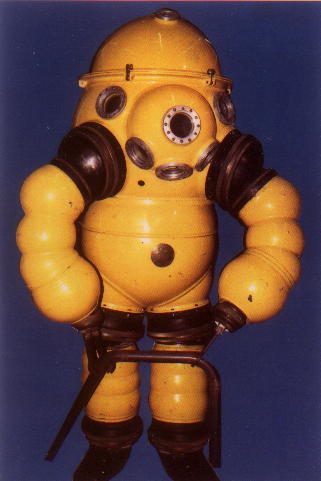As we said before, mixed gas and saturation
developments stagnated the developments of atmospheric diving suits. These
methods however are very expensive. In the seventies the oil companies did not
have a problem with the high rates. Oil was booming business at that time and
they were making a lot of money on it.
In the nineteen eighties the market shrunk and
competition grew. Oil companies wanted more "value for money". For
this reason designers were still interested in atmospheric diving suits.
In 1984 Phill Nuytten got a patent on an oil filled
rotary joint. The joint uses oil as the bearing surface and features very small
knife edges that ride in a deformable plastic. The joint also features a
free-floating central piston. As the pressure increases, the piston uses the
bearing fluid to lift the knife edges. This prevents further embedment into the
seal material. This unique design keeps the joint easily movable, even at great
depth.
The nuit suit has 20 joints in 6 different sizes. The
wrist joint is the smallest, the hip one the largest. Compared to the other
suits like JIM the nuit suit conforms more closely to the human body increasing
the divers mobility. Suit and joints are made of aluminum. Two separate oxygen
rebreather systems support life for 40 hours.
The umbilical features the surface communication
system. A wireless communication system is available for backup. The nuit suit
is the best atmospheric diving suit so far and has several advantages:
- it can work in midwater thanks to propellers and
thrusters that the divers operates with his feet
- there are no decompression problems
- the use of the suit is a lot cheaper than using
saturation diving
- The whole rig fits in a container that can be easily
transported all over the world
- You do not need a lot of space on deck
- The supporting crew is smaller than using saturation
diving
However, like its predecessors, it has
some drawbacks also.
For instance, it can not work in extremely turbid
waters. Dive jobs are nearly always performed in turbid waters. A diver often
needs his "fingertip feeling" to work.
Besides this the smallest current makes it hard to work
in the suit. It has a large surface and will catch a lot of water.



